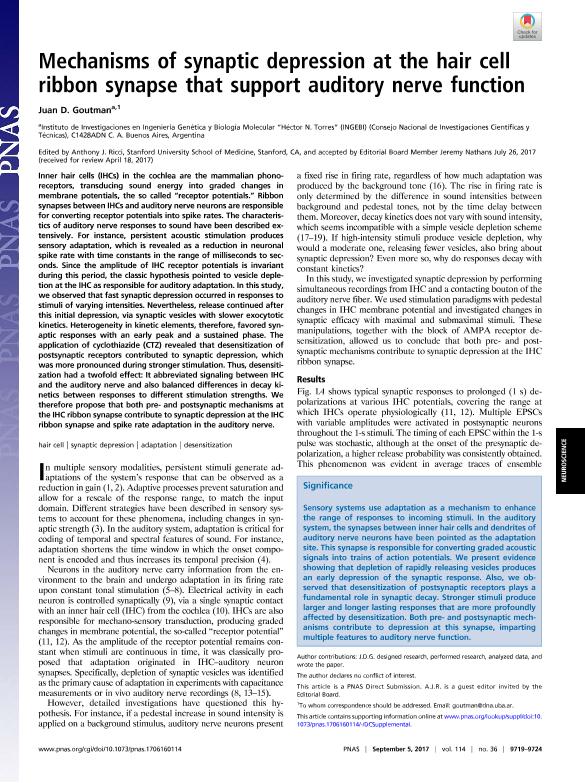Mostrar el registro sencillo del ítem
dc.contributor.author
Goutman, Juan Diego

dc.date.available
2018-05-21T16:30:45Z
dc.date.issued
2017-09
dc.identifier.citation
Goutman, Juan Diego; Mechanisms of synaptic depression at the hair cell ribbon synapse that support auditory nerve function; National Academy of Sciences; Proceedings of the National Academy of Sciences of The United States of America; 114; 36; 9-2017; 9719-9724
dc.identifier.issn
0027-8424
dc.identifier.uri
http://hdl.handle.net/11336/45750
dc.description.abstract
Inner hair cells (IHCs) in the cochlea are the mammalian phono-receptors, transducing sound energy into graded changes in membrane potentials, the so called “receptor potentials.” Ribbon synapses between IHCs and auditory nerve neurons are responsible for converting receptor potentials into spike rates. The characteristics of auditory nerve responses to sound have been described extensively. For instance, persistent acoustic stimulation produces sensory adaptation, which is revealed as a reduction in neuronal spike rate with time constants in the range of milliseconds to seconds. Since the amplitude of IHC receptor potentials is invariant during this period, the classic hypothesis pointed to vesicle depletion at the IHC as responsible for auditory adaptation. In this study, we observed that fast synaptic depression occurred in responses to stimuli of varying intensities. Nevertheless, release continued after this initial depression, via synaptic vesicles with slower exocytotic kinetics. Heterogeneity in kinetic elements, therefore, favored synaptic responses with an early peak and a sustained phase. The application of cyclothiazide (CTZ) revealed that desensitization of postsynaptic receptors contributed to synaptic depression, which was more pronounced during stronger stimulation. Thus, desensitization had a twofold effect: It abbreviated signaling between IHC and the auditory nerve and also balanced differences in decay kinetics between responses to different stimulation strengths. We therefore propose that both pre- and postsynaptic mechanisms at the IHC ribbon synapse contribute to synaptic depression at the IHC ribbon synapse and spike rate adaptation in the auditory nerve.
dc.format
application/pdf
dc.language.iso
eng
dc.publisher
National Academy of Sciences

dc.rights
info:eu-repo/semantics/openAccess
dc.rights.uri
https://creativecommons.org/licenses/by-nc-sa/2.5/ar/
dc.subject
Hair Cell
dc.subject
Ribbon Synapse
dc.subject
Synaptic Depression
dc.subject
Auditory Nerve
dc.subject.classification
Inmunología

dc.subject.classification
Medicina Básica

dc.subject.classification
CIENCIAS MÉDICAS Y DE LA SALUD

dc.title
Mechanisms of synaptic depression at the hair cell ribbon synapse that support auditory nerve function
dc.type
info:eu-repo/semantics/article
dc.type
info:ar-repo/semantics/artículo
dc.type
info:eu-repo/semantics/publishedVersion
dc.date.updated
2018-05-03T21:06:05Z
dc.journal.volume
114
dc.journal.number
36
dc.journal.pagination
9719-9724
dc.journal.pais
Estados Unidos

dc.journal.ciudad
Washington
dc.description.fil
Fil: Goutman, Juan Diego. Consejo Nacional de Investigaciones Científicas y Técnicas. Instituto de Investigaciones en Ingeniería Genética y Biología Molecular "Dr. Héctor N. Torres"; Argentina
dc.journal.title
Proceedings of the National Academy of Sciences of The United States of America

dc.relation.alternativeid
info:eu-repo/semantics/altIdentifier/doi/http://dx.doi.org/10.1073/pnas.1706160114
dc.relation.alternativeid
info:eu-repo/semantics/altIdentifier/url/http://www.pnas.org/content/114/36/9719
Archivos asociados
